The Historical Trend
Previous generations of U.S. soldiers did not display the same number or variety of awards. An evolution can be seen in the wear of the uniform as exhibited by well-known Generals of wars past.
General Ulysses S. Grant, General Dwight D. Eisenhower, and General George C. Marshall wore few awards. This is in part due to the fact that far fewer awards existed during each General’s career time frame, but the overall appearance was far more conservative in nature.
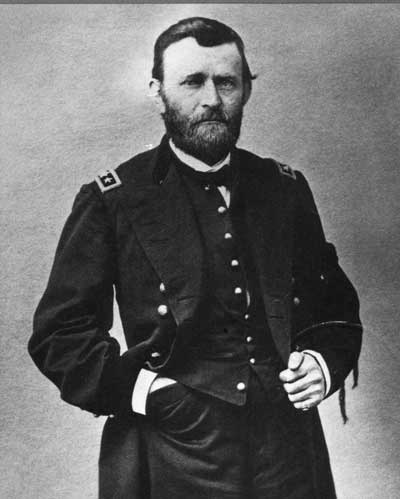


Now compare the appearance to contemporary Generals. General David Petraeus, General McChrystal, and General Odierno all wear far more awards and badges. They are certainly within the regulations to wear the uniform as approved by the military; the question is how the number of awards has gotten to current levels.
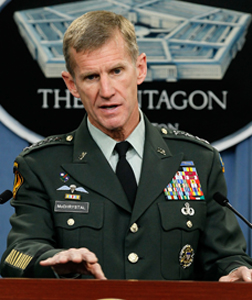


Of course, there are outliers to this generational pattern. General Patton was well known for his flamboyant uniform. General Dempsey often wore only two rows of awards despite having far more. The question remains, how did the awards system get to where it is now?
Number of Awards Doubled
A primary reason for the increase is the number of personal awards created following World War II. In 1945, eight individual awards existed (in order of precedence), only two of which were non-combat related:
- Medal of Honor
- Distinguished Service Cross
- Distinguished Service Medal (Non Combat Award)
- Silver Star
- Distinguished Flying Cross
- Soldier’s Medal (Non Combat Award)
- The Bronze Star
- Purple Heart
Fast-forward to current day, and the number of personal awards has doubled by eight, including a 450% increase in medals that can be awarded in non-combat related actions. New awards are listed in bold.
- Medal of Honor
- Distinguished Service Cross
- Defense Distinguished Service Medal
- Distinguished Service Medal (Non Combat Award)
- Silver Star
- Defense Superior Service Medal
- Legion of Merit
- Distinguished Flying Cross
- Soldier’s Medal (Non Combat Award)
- Bronze Star (Valor or Achievement)
- Purple Heart
- Defense Meritorious Service Medal
- Meritorious Service Medal
- Air Medal (Valor or Achievement)
- Joint Service Commendation Medal (Valor or Achievement)
- Army Commendation Medal (Valor or Achievement)
Of those awards, the following are generally only awarded to senior officers and senior enlisted members.
- Defense Distinguished Service
- Distinguished Service Medal
- Defense Superior Service Medal
- Legion of Merit
- Defense Meritorious Service Medal
- Meritorious Service Medal
- Joint Service Commendation Medal
Clearly, there has been a change in the U.S. Military on what kind of performance justifies the awarding of a medal. In past generations, the focus was on combat heroics, not achievement while performing the tasks associated with the job. The priority now seems to weigh towards non-combat related actions.
With this large number of non-combat personal awards, it begs the question of whether these are needed to truly increase morale and reward performance, or are expected upon completing time in a specified billet.
Why are everyday actions of a soldier or officer in garrison rewarded with medals today, when so few existed fifty years ago? Has the current system inflated expectations and created a self-perpetuating cycle of new awards, handed out too easily?
Combat Zone Participation Award: The Bronze Star Example
“The fact that the ground troops, Infantry in particular, lead miserable lives of extreme discomfort and are the ones who must close in personal combat with the enemy, makes the maintenance of their morale of great importance.” General George C. Marshal, Feb 3, 1944
With this statement from General Marshall came the creation of the Bronze star, intended to highlight the actions of ground troops during World War II. It was retroactively awarded in 1947 to all service members whom had been awarded a Combat Infantryman Badge or Combat Medical Badge.
The criterion for awarding the Bronze Star was refined by President Kennedy in 1962 due to the rising advisory role in Vietnam. The new criteria established the requirements for the medal, and remain in place for today.
“Awarded to any person who, after December 6, 1941, while serving in any capacity with the Armed Forces of the United States, distinguishes himself or herself by heroic or meritorious achievement or service, not involving participation in aerial flight, under any of the following circumstances:
(1) While engaged in an action against an enemy of the United States. A-7
(2) While engaged in military operations involving conflict with an opposing foreign force.
(3) While serving with friendly foreign forces engaged in an armed conflict against an opposing armed force in which the United States is not a belligerent party.
- When the Bronze Star is awarded for heroism, a bronze letter “V” (for valor) is worn on the suspension and service ribbon of that medal.” Executive Order 9419 Bronze Star Medal
By allowing service members “in any capacity within the Armed Forces” to be awarded the Bronze Star for meritorious achievement, members of staff or support positions were eligible as long as they were serving in a combat zone.
The advent of the valor device for heroism is meant to distinguish those actively engaged in ground combat with the enemy from those in support positions.
However, the statistics of contemporary conflicts displays an increasing disparity in the number of medals awarded for heroic action in comparison to those awarded for meritorious achievement.
Bronze Stars Compared – Vietnam, Iraq, & Afghanistan
A stark contrast is observed when tracking the ratio of valor and meritorious achievement of Bronze Stars awarded between the conflicts in Vietnam, Iraq, and Afghanistan.
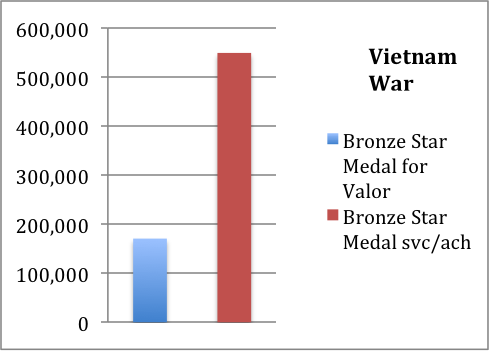
- Valor Awards – 170,626
- Meritorious Achievement Awards – 549,342
- Ratio – 1 : 3
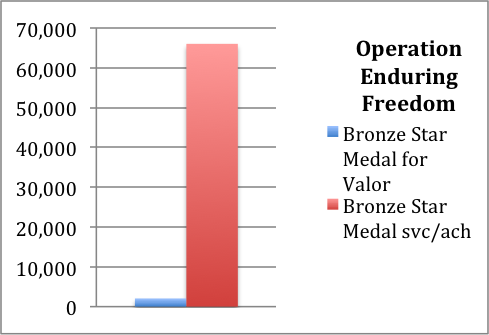
- Valor Awards – 2,055
- Meritorious Achievement Awards – 66,040
- Ratio – 1 : 32
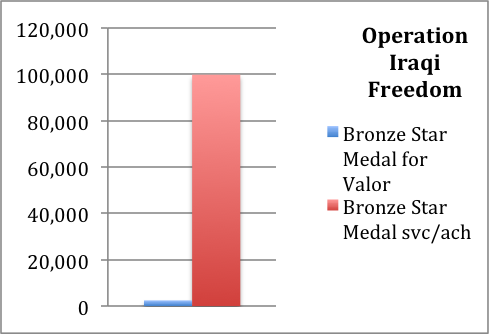
- Valor Awards – 2,461
- Meritorious Achievement Awards – 99,886
- Ratio – 1 : 40
These statistics show an increasing trend of Bronze Stars awarded for service and achievement, while far fewer valor awards have been given.
Higher levels of combat in Vietnam led to the deaths of 58,220 U.S. troops. In Iraq and Afghanistan, the total death count is 6,810 U.S. troops. While this may partially explain the reduced number of valor awards, it does explain the inflated ratio of Bronze Stars for meritorious achievement.
Awards and Rank: The Silver Star Example
The Silver Star does not distinguish between valor and meritorious service. It is intended to only award those who have performed heroic actions in combat.
The official criteria as outlined in DoDM 1348.33 states:
The Silver Star may be awarded to any individual while serving with the U.S. Armed Forces, who distinguishes himself or herself through gallantry in action under any of the following circumstances:
- While engaged in an action against an enemy of the United States.
- While engaged in military operations involving conflict with an opposing foreign force.
- While serving with friendly foreign forces engaged in an armed conflict against an opposing armed force in which the United States is not a belligerent party.
- The required gallantry, while of a lesser degree than that required for award of the Army Distinguished Service Cross, the Navy Cross, or the Air Force Cross, must nevertheless have been performed with marked distinction.
- The Silver Star medal may be awarded posthumously.
There is no rank or time in service requirement for the Silver Star. Yet the numbers from Iraq and Afghanistan show that a disproportionate number of officers and senior non-commissioned officers (NCO), likely in command or leadership positions, are awarded the medal over junior enlisted troops.

As the above chart shows, the overwhelming majority (68% of total) of those awarded the Silver Star in Iraq and Afghanistan were Officers and E-6’s or above. This number included two Generals.
When compared to the overall military deaths in Iraq separated by rank, the totals do not seem to match. Those in the ranks of E-1 to E-4 represented nearly 60% of total number. The Department of Defense data included E-5’s, or Sergeants, into the senior enlisted totals. It would be expected that Sergeants included in the junior enlisted category would raise that percentage significantly.
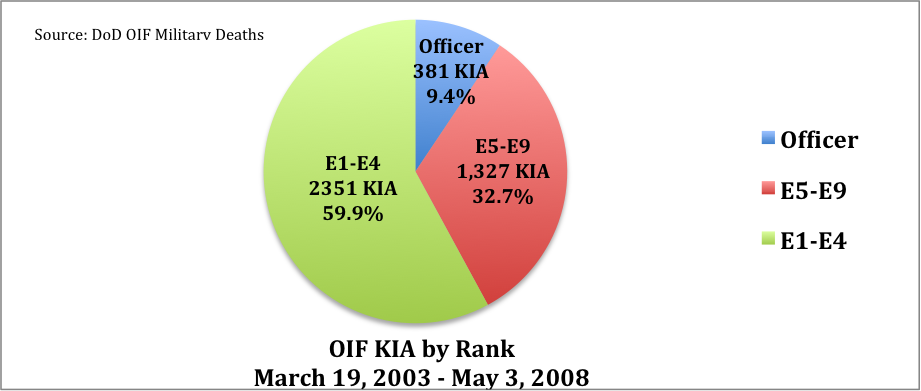
If junior enlisted soldiers conduct the majority of combat operations and experience the heaviest levels of casualty rates, why do they receive such a disproportionately low number of Silver Stars?
The argument can be made that the responsibility of leadership within the officer and senior enlisted ranks makes them a more viable candidate for higher awards. While this responsibility should not be underestimated, it does not necessarily validate the huge disparity in who the Silver Star is ultimately awarded to.
Nowhere within the criteria for the Silver Star does it state that a leadership billet or rank must be held in order to eligible for the medal. Does a double standard exist for junior enlisted soldiers within the awards system? Are officers and senior enlisted nominated for the Silver Star more easily approved?
Medals as an Extension of the Fitness Evaluation System
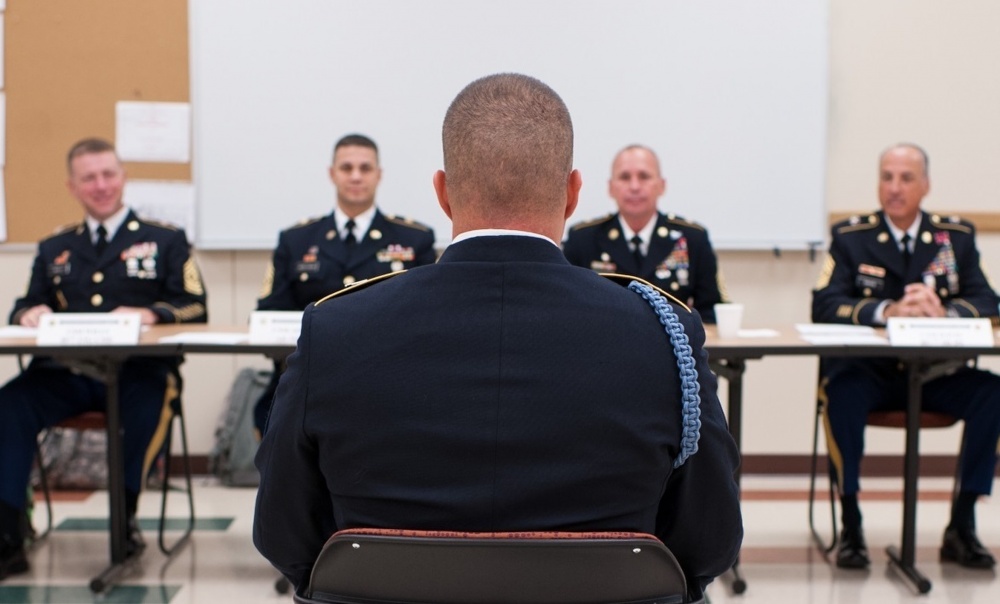
As the military draws down on forces, the competition for promotion, especially within the officer ranks, has grown significantly. For example, the 2016 Army selection rates for promotion to Lieutenant Colonel was 60%. In past years, the selection rate ranged between 80-90%.
What is the correlation between the number and type of medals the individual has been awarded, and his or her chances of being selected for promotion? Has it led to an inflation of awards to make soldiers more competitive for promotion?
Both the Army and Marine Corps both have blocks on their respective evaluation forms to include awards received in the time frame the soldier is being evaluated for.
Lets say a promotion board is reviewing two Major’s up for promotion to Lieutenant Colonel. Both have similar rankings by their senior reviewer’s which place them on the border of the 60th percentile.
Both Major’s have held the required number of command and staff billets, with similar levels of education. However, one major has a Bronze Star for meritorious achievement, while the other does not. Will that be a determining factor in deciding who is selected for promotion, and who is not?
If this scenario is true, then it may lead to a self-perpetuating cycle of awarding those close to the commanding officer in order to ensure their success at promotion boards. This cycle could lead to an inflation of the military awards system at large, and explain why it seems every officer and senior enlisted soldier is awarded a medal at the conclusion of a deployment or at their end of tour with a unit.
Does every PCS move truly warrant a end of tour award? If evaluations are meant to measure performance, should you get a medal for doing your job well?
Medals as a Political Shield: The Oliver North Example
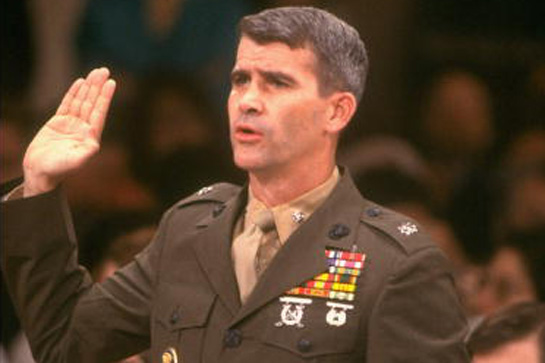
In 1986, Lt. Col. Oliver North was brought before a congressional hearing regarding his involvement in the Iran-Contra Affair. Clean cut and wearing his Marine uniform with military awards (to include a Silver Star for actions in Vietnam), North looked every part of the dedicated officer.
Many conservative media outlets portrayed Lt. Col. North as the victim, a war hero who was conducting an operation with the approval of his superiors and a scapegoat to gray suited Congressmen. He quickly began to garner public support, raising thousands of dollars from private donors to cover his trial expenses.
This depiction continued despite the fact that the Committee Chairman, Senator Inouye, was a Distinguished Service Cross winner (later upgraded to the Medal of Honor) and a single arm amputee from World War II.
North was eventually convicted of three charges, with heavy fines and a suspended jail sentence. The convictions were later overturned, and North has become a popular public figure in conservative news outlets.
The image of North in full uniform with medals on display testifying before Congress was a powerful tool in establishing the persona of a military man unfairly questioned by the civilians he protected.
This depiction of Oliver North is an example, and possible foundation for military officials wearing their various awards in front of the public eye. It is hard to argue against a General in full regale when put on camera, every word and gesture shown on the evening news.
Do medals worn on the chest of Generals in the highlighted by the media signify that they should not be questioned on military affairs?
During the conflicts in Iraq and Afghanistan, the military hearings before Congress were highly publicized. This included leaks in 2009 to the media about troop level recommendations, generally credited to high ranking military officials to ensure Congress and the President acted upon their recommendations. A battle for the perceptions of the American people was critical during two wars that saw sharp declines in public support.
General David Petraeus’ awards were on full display during congressional hearings regarding the troop level surge in Iraq. General McChrystal did the same during similar discussions regarding Afghanistan.
The effect of these Generals in their decorated uniforms seems to have had a similar effect to the Oliver North example. How can these generals, with all of their medals, be wrong? The awards represent their cumulative knowledge and experience in military matters, and are exhibited when in front of the camera.
To be clear, these Generals were fully within regulations to wear the uniform and medals… but are they truly needed?
On the opposite side of the spectrum stands recently retired Joint Chiefs of Staff, General Martin Dempsey. Generally considered an intelligent and reserved Army officer, he made a point of only wearing two rows of his awards while in military uniform. This aligned with his overall approach to appearances, as he removed all expensive furniture from his personal office at the Pentagon.
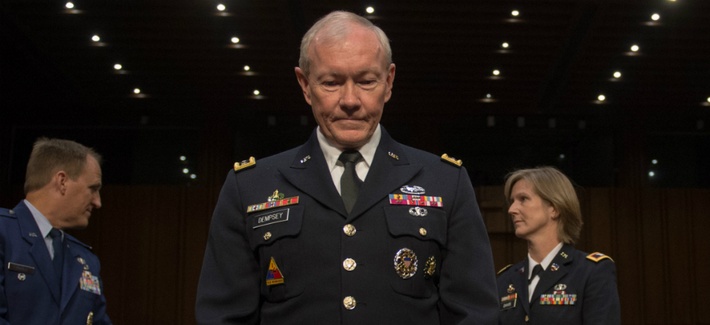
This is a stark contrast to his peers in the General officer ranks. Why did General Dempsey decide on a more conservative appearance, while others wear every medal, ribbon, and badge that have earned over a thirty to forty year career?
Are Medals Cheapened Now?
The vast array of military medals, especially those not received for heroic actions in combat, have expanded and evolved quickly since World War II.
The number of awards has increased twofold, and the propensity to award meritorious achievement, such as the Bronze Star, has increased dramatically.
A medal designed for heroic action, the Silver Star, does not seem to be awarded as often to those who do the vast majority of the fighting.
Possible explanations include the promotion board system, or perhaps an effort to increase positive public perception. Undoubtedly, commanders want to recognize the efforts of troops who go far and above expectations. However it appears that every soldier now receives an award for simply doing his or her job.
Have achievement medals been cheapened to participation awards? Have medals become a extension of an the military evaluation system to inflate a soldier’s record? Are they unnecessarily inflating the appearance of military members when in dress uniform?
You Might Also Like Is There a Silver Star Award Bias Against Junior Enlisted?
Sources
https://www.navytimes.com/articles/navy-secretary-recommends-two-medals-of-honor
https://warisboring.com/it-s-hard-to-tell-war-heroes-from-paper-pushers-when-everybody-gets-so-many-dumb-ribbons-9880c02e718c#.q4s5w
https://warisboring.com/it-s-hard-to-tell-war-heroes-from-paper-pushers-when-everybody-gets-so-many-dumb-ribbons-9880c02e718c#.q4s5weico
http://www.nbcnews.com/id/4243092/ns/world_news-brave_new_world/t/too-many-medals/#.WEsYDqIrJcA
http://taskandpurpose.com/the-military-needs-to-get-a-handle-on-its-awards-process/
http://www.slate.com/articles/news_and_politics/war_stories/2004/09/who_really_deserves_a_silver_star.html
http://www.newsweek.com/us-military-officers-too-many-medals-80701
http://www.telegraph.co.uk/news/uknews/defence/11155786/Shamed-Army-major-stripped-of-gallantry-award-after-exaggerating-own-bravery.html
https://www.dmdc.osd.mil/dcas/
https://www.rallypoint.com/command-post/the-bronze-star-medal-military-misconceptions
http://www.stripes.com/pentagon-to-review-all-military-medals-1.264455
https://www.hrc.army.mil/content/Awards%20and%20Decorations%20Statistics%20by%20Conflict
http://www.amervets.com/replacement/bs.htm#isr
http://valor.defense.gov/Recipients/Army-Silver-Star/
DA PAM 623-3 Evaluation Reporting System
https://www.armytimes.com/story/military/careers/army/officer/2016/04/14/army-releases-lieutenant-colonel-promotions-selection-rates/83024962/
“Loss of Confidence: The Failure of the Army’s Officer Evaluation and Promotion System and How to Fix it” Tier, David, Small Wars Journal
http://www.gallup.com/poll/189848/no-improvement-congress-approval.aspx